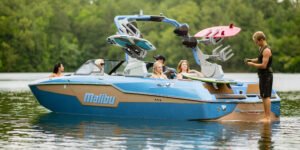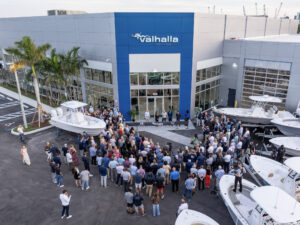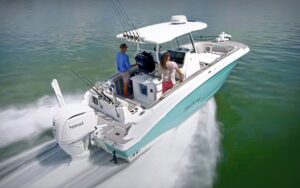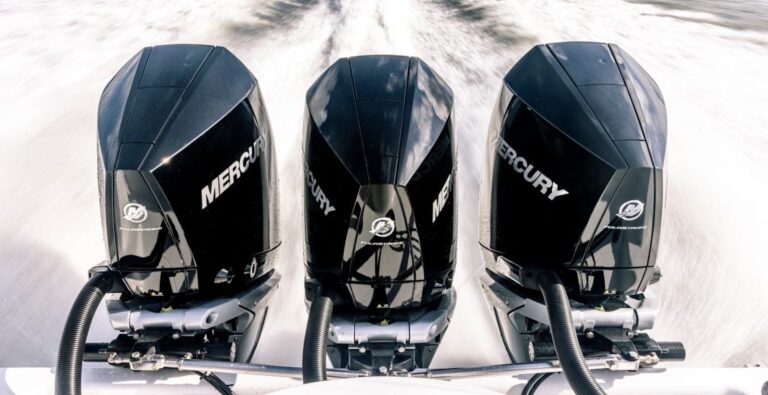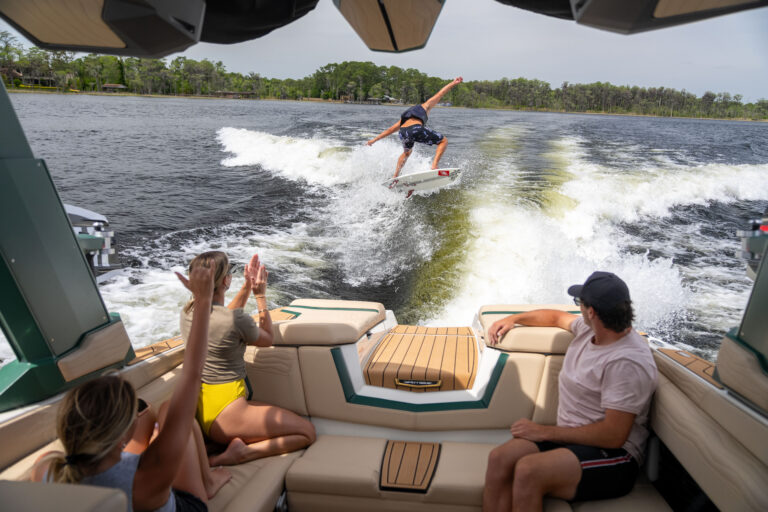
At a press conference yesterday at the Fort Lauderdale International Boat Show, Brunswick Corp. CEO David Foulkes went over new developments taking place inside the brands, while also outlining its general strategy going forward. The company has released information about initiatives and new projects over the past year, but Foulkes’ hour-long talk to the media on the range of developments across Brunswick underscored its plans to overhaul the company through technology and innovation.
“We don’t take being a leader in the marine industry for granted,” Foulkes told the boating writers. “Everyone needs to earn leadership. Just to stay in the position we’re in, we need to have advanced innovation capabilities, a portfolio of service and shared-access businesses, and an ongoing commitment to product development.
Foulkes said that the “three big parts” to Brunswick include Mercury propulsion, its parts and accessories business, and the Brunswick Boat Group.
The company also has five pillars that define its culture, he said, including “exceptional products and brands, operating and quality excellence, best employer and partner, customer-centric innovation, and frictionless consumer experiences.”
Brunswick has been investing heavily in innovation and emerging technologies across multiple fronts. Foulkes noted that technology is “moving really fast” across its different segments, including Mercury Marine and its 17 boat brands, so Brunswick has established “centers of excellence” to “leverage its scale.”
Last summer, it completed a $12 million center at Mercury’s headquarters in Fond du Lac, Wis., dedicated to the study of noise, vibration and harshness. The Brunswick Boat Group also recently opened a Technology Center at its Boston Whaler facility in Florida, with 45,000-square-feet of offices for 160 designers, naval architects and experts in computer simulation to oversee the development of Boston Whaler and Sea Ray models. It also recently opened a design center for its pontoon boat division.
“This does not mean we will dilute our brands’ identities,” Foulkes said. “In fact, it’s much easier to dilute the brands if they are working in a vacuum. This allows us to manage the brands more effectively and enhance their capabilities.”
Foulkes also spoke about different initiatives for emerging technologies, including the i-Jet Lab on the main campus of the University of Illinois, where new technologies are developed for its companies. The lab works with about 25 students on a range of projects, from virtual reality to telematics. “These people have skill sets that we don’t have internally,” Foulkes said. “We will leverage these skills over time and eventually have them as part of our organization.”
Foulkes also spoke about Brunswick’s Loop Lab in downtown Chicago with its Nautic-On telematics business, adding that “a lot of other things are going on in that lab.” Its partnership with TechNexus allows Brunswick to invest in boating and fishing startups. “We do minority investments, currently about 10 or so — that allows us to build out our eco-systems in different segments,” he said.
The company also has invested in a Boston-based company called Sea Machines, which designs autonomous vessels. “Their technology is designed for commercial vessels, but will also be applicable to recreational boats,” he said. “But it gives a sense of how we are moving forward.”
Brunswick is also viewing future boating technology through the acronym ACES: autonomy, connectivity, electrical and shared access. “We see these components, autonomous control, connected vessel, electrical systems and shared access — think Uber — as important for the marine business,” Foulkes said. “It doesn’t mean our objectives are the same as the auto industry, for instance, but they all will be critical to boating moving forward.”
Foulkes said Brunswick would continue with new-model launches this year after several years of aggressive product development. At FLIBS, Boston Whaler launched the 325 and 405 Conquest and Sea Ray introduced the 320 Sundancer Coupe outboard. Mercury Racing’s 450R outboards are on boats across the show this week.
“As we move into 2020, you’ll see a lot more product from us,” Foulkes said, noting that Brunswick would demonstrate marine technology at the 2020 Consumer Electronics Show in January. “It will give marine technology a broader sense of context to the rest of the world,” he said.
Asked about the costs of technology making boating less affordable, Foulkes said technology “gets cheaper when it’s more widely used,” and that Brunswick plans to use its Nautic-On telematics system on boats larger than 25 feet. “The other thing we can do is make sure we have scalable solutions,” he said. “We see Mercury Vessel View gaining more capabilities but providing an entry point for boats under 25 feet. Nobody wants to have that technology on boats more than us.”
Foulkes said Brunswick might acquire more marine companies going forward. “We could also potentially invest in companies that are interested in the marine environment,” he said.


